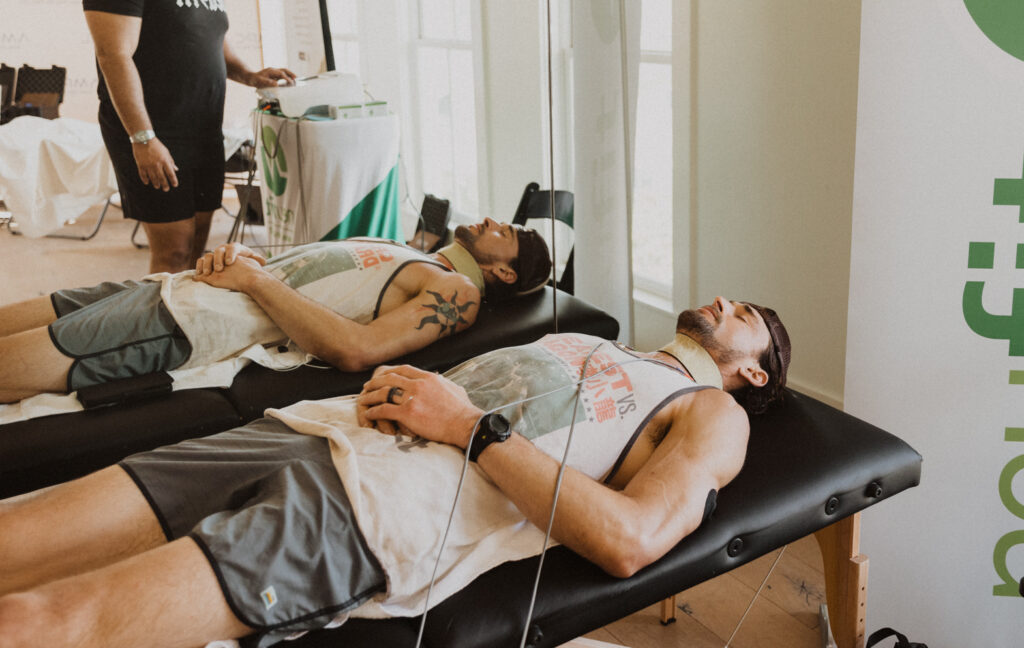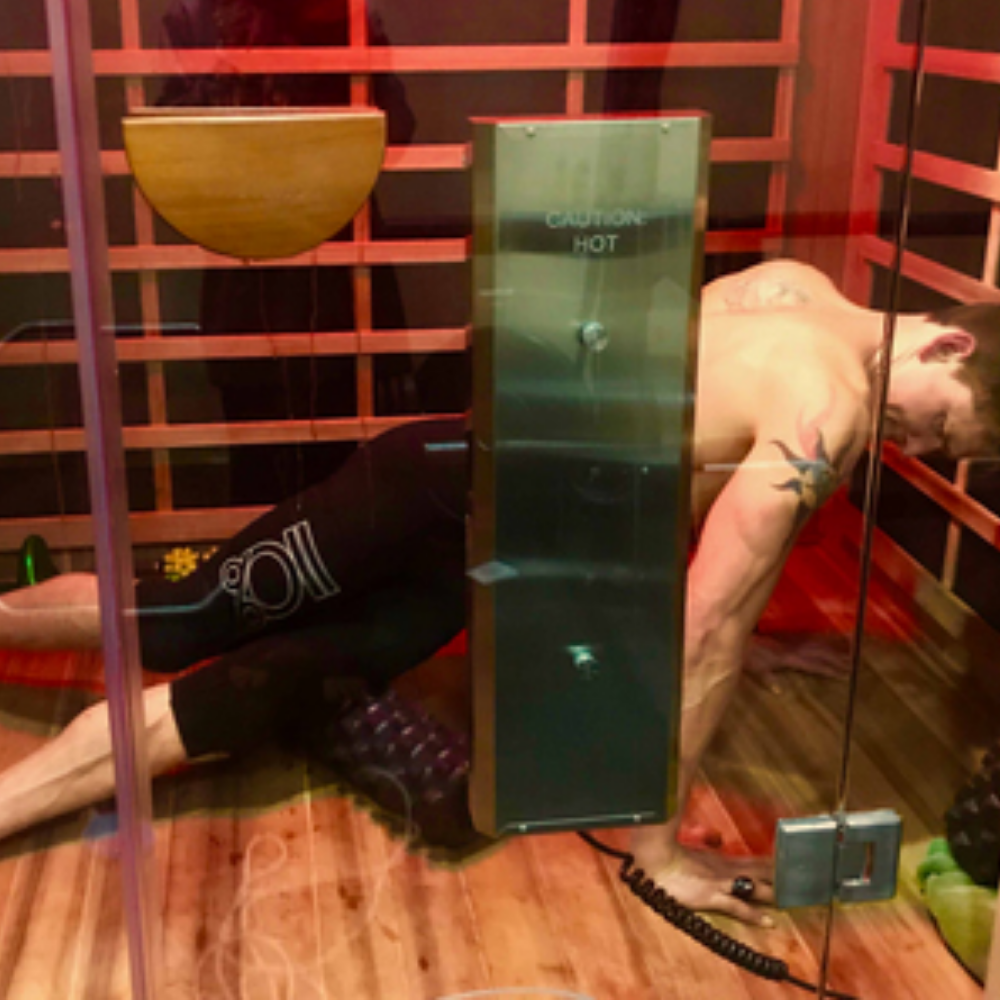July 9, 2024
“You ready?”
I nodded and gulped. The guy in the polo shirt and glasses standing next to me flipped the green switch in his hands, and suddenly my abs—covered in a Christmas-light-esque array of blinking electrodes—exploded into an intense contraction that shook my body from head to toe.
For a painfully long two minutes, he continued the stimulation with a fringe Russian-training-inspired electrical muscle recruitment device (called the “Neubie”), then finally switched it off and, smiling, stepped away. I wiped the beads of sweat from my forehead and stared down at my quivering ab muscles, now forming a neat, tight six-pack.
“Dang.”
“Yeah, and tomorrow you’re going to feel like you did a thousand crunches.”
When it comes to extreme exercise efficiency, this machine—which can simulate a 600-pound squat with just a few flimsy electrode pads—ranks right up there with the altitude simulation device LiveO2 in my home gym, the whisper-soft Walkolution foam-lined treadmill at my office desk, my full-body cryotherapy, cardio, and blood flow restriction VASPER (promising to give the equivalent of a three-hour run in twenty-one short minutes), the industrial-size vibration Powerplate next to my kettlebells, the wearable Katalyst electrical muscle stimulation suit, and the enormous pulley-piston-driven ARX machine that basically simulates fighting a giant 2-horsepower robot.
Sure, all this may sound quite fancy and complex, but the truth is that you don’t need to empty your wallet or spend oodles of time cracking the code to get the body you want.
Suppose you want to live as long as possible. Suppose you also want to look as good as possible doing it. Suppose you want to maximize your hormone balance, drive, fertility, strength, power, and cardiovascular capacity. Suppose you want to step back, investigate every shred of exercise research, and inject only the most effective strategies into your life—not to prepare for masochistic suffer-fests like triathlons, marathons, obstacle races, or other feats of physical endurance, but rather to maximize longevity and look good naked.
Whether you're considering total caloric intake, exercise, sunlight exposure, protein consumption, or work habits, it's often believed that you need to do far more than necessary to achieve your desired results.
Why crank out those extra reps or put in those extra hours if you don’t have to? After all, failing to heed the minimum effective dose can often cost you money, time, and mental real estate.
In the first section of this article, you'll discover the truth about how much exercise you really need to live a long time, with the approach that traditional Chinese medicine considers to be the ultimate way to be boundless: a balance of easygoing yin and hard-charging yang. You will also find a done-for-you exercise program you can do for the rest of your life (at any time and in any place) while maintaining the sweet spot between health, performance, and longevity.
The Minimum Effective Dose of Exercise
In 2015, the New York Times published “The Right Dose of Exercise for a Longer Life.” The article discusses the results of two studies that investigated how much exercise is needed to reap longevity benefits. But before jumping into those results, it is important to note that rather than being controlled or randomized, these studies relied upon the participants’ memory recall of their exercise habits. Like diet studies that rely on memory recall of meals, these kinds of studies can be prone to human error. But they can still give you important information.
The first study found that people who did not exercise at all faced the highest risk of early death. Those who exercised a little—not meeting the current American Heart Association guidelines of 150 minutes per week, but at least doing something—reduced their risk of premature death by 20 percent. Those who performed 150 minutes of moderate exercise per week enjoyed a 31 percent lower risk of dying than those who never exercised.
But the greatest benefits came to those who exercised moderately, mostly by walking, for 450 minutes per week—a little more than an hour per day. These people were up to 39 percent less likely to die prematurely than those who never exercised.
Even more interesting is the fact that after 450 minutes per week, the longevity benefits of exercise plateaued but never significantly declined. Those who performed ten times or more the recommended exercise dose never really got any extra benefits than those who exercised at a dose closer to the recommended guidelines. While their risk of dying young did not increase, they also did not get significantly healthier from a longevity standpoint, suggesting that an excess of easy, aerobic exercise isn’t going to hurt you, but it also isn’t going to provide any further decrease in mortality risk.
The second study reached a similar conclusion but focused more on exercise intensity. The results stand in stark contrast to studies that suggest frequent strenuous exercise might contribute to early mortality. Not surprisingly, this study found that meeting exercise guidelines significantly reduced the risk of early death, even if that exercise was as moderate as walking.
However, those who engaged in occasional vigorous, high-intensity exercise saw an additional reduction in mortality risk. People who spent up to 30 percent of their weekly exercise time in vigorous activities were 9 percent less likely to die prematurely than people who exercised at a moderate intensity for the same amount of time. People who spent more than 30 percent of their exercise time doing strenuous workouts gained an extra 13 percent reduction in early mortality risk compared to those who never broke through that intensity barrier. Even the few people in the study who engaged in the greatest amounts of intense exercise had no increase in mortality risk.
At this point, you may be wondering what qualifies as moderate and what qualifies as vigorous.
- Moderate-intensity aerobic exercise raises your heart rate and makes you sweat. You’ll know if you’re working at a moderate intensity if you can’t sing a song during a workout but you can still talk.
- Vigorous-intensity aerobic exercise makes you breathe hard and fast, makes your muscles burn, and significantly increases your heart rate. If you are working at this level, you won’t be able to say more than a few words without pausing for a breath.
What’s the ultimate takeaway from these two studies? Researcher Klaus Gebel, who led the second study, said, “Try to reach at least 150 minutes of physical activity per week and have around 20 to 30 minutes of that be vigorous activity.”
Ultimately, all this research suggests that you need at least 20 minutes of structured exercise per day if you want to live a long time—assuming, of course, that you’re engaged in low-intensity physical activity for much of the rest of the day (taking standing and stretching breaks, walking, using the stairs, etc).
Get Fit, Live a Long Time, and Look Good Naked
It is one thing to live a long time and another thing entirely to look as good as possible doing it.
Frankly, no matter what “looking good naked” means to you, you are going to need a bit more than a blanket recommendation to perform at least 150 minutes of physical activity per week and have 20 to 30 minutes of that be vigorous activity.
Probably due to my graduate studies in exercise physiology and biomechanics, I tend to be systematic when it comes to my approach to a complete fitness program, meaning I step back and look at the body as a series of metabolic systems. If each of these six systems (listed below) is effectively targeted in any given week, you’ve checked off what you need for the best possible approach to building and maintaining fitness, very similar to how a nutritional approach should ideally guarantee a weekly adequate intake of vitamins, minerals, sugars, fatty acids, and amino acids.
6 Major Aspects of Training to Balance Aesthetics, Fitness, and Longevity
1. Cardiovascular Fitness
Cardiovascular fitness is defined as the maximum amount of oxygen you can utilize, an amount called VO2 max (also known as maximal oxygen consumption, maximal oxygen uptake, peak oxygen uptake, or maximal aerobic capacity). This is simply your maximum rate of oxygen consumption during intense exercise, and it is heavily correlated with overall fitness, health, and longevity.
Studies show that the minimum effective dose for maintenance of cardiovascular fitness is five four-minute high-intensity rounds at 87 to 97 percent of your maximum heart rate, with four minutes of rest or low activity after each round to allow you to recover sufficiently (a 1:1 work:rest ratio).
For the minimum effective dose of cardiovascular fitness, perform five intense four-minute interval training sessions with full rest periods, such as five four-minute efforts on a bicycle, with each effort followed by four minutes of easy pedaling. Do a session like this once every one to two weeks.
Interestingly, research shows that combining aerobic training (concurrent training) with resistance training can provide further VO2 max benefits, making a good case for adopting this workout to the style of VO2 max training I prefer: a four-minute maximum sustainable effort of cardio, then one set of a major lift to failure such as chest press, then back to cardio, and repeated for a few other lifts, like the shoulder press, squat, pull-down, deadlift, or row. The added bonus is that this strategy beats the boredom of being on a treadmill or bike for thirty-plus minutes.
2. Maximum Muscular Endurance and Aerobic Capacity
Your maximum muscular endurance is, as the name suggests, the maximum amount of work your muscles can endure, and it is related to your mitochondrial health, your muscular resistance to fatigue, and your ability to buffer lactic acid.
For muscular endurance and aerobic capacity, nothing beats Tabata sets, which deliver a perfect 2:1 work:rest ratio that results in lactic acid accumulation. A Tabata requires four minutes of going all-out at absolute maximum intensity for twenty seconds, resting for ten seconds, and repeating for a total of eight rounds.
Your set doesn’t have to be on a cardio machine or during a run. For example, in one study, participants performed a Tabata session with a single exercise four times a week for four weeks. Exercise choices included burpees, mountain climbers, jumping jacks, and squat thrusts, but you could also engage in treadmill or outdoor running, rowing, kettlebell swings, or indoor or outdoor cycling.
Compared to four thirty-minute steady-state treadmill exercise protocols per week in the control group, the Tabata group (which, if you do the math, was performing just sixteen minutes of exercise per week) saw significant gains in both aerobic capacity and muscle endurance.
Most studies use two to four Tabata sessions per week. I recommend performing two Tabata sessions per week, and it’s fine to do them as a warm-up or finisher to any strength training or mobility routine.
3. Ideal Strength-to-Muscle-Mass Ratio
If you can muster massive amounts of power in small, tightly packed groups of muscle fibers and maintain wiry and explosive muscle like a powerlifter, you’ll have the type of muscle most correlated to longevity. Bigger muscles aren’t necessarily better, although a certain amount of muscle mass allows you to experience all the metabolic, neural, and immune benefits of muscle championed by my friend, the “muscle-centric medicine” physician Dr. Gabrielle Lyon (you can check out my recent podcast with her here). For example, a healthy lean muscle percentage range is 70 to 90 percent, so if your ideal body weight is 180 pounds, your total amount of necessary muscle is 126 to 144 pounds, and that muscle should be as functional and strong as possible.
The best way to achieve the ideal strength-to-muscle-mass ratio with a minimum effective dose of exercise involves just two to four short workouts per week to target both muscle mass and power.
The first workout is a super-slow lifting protocol. Hit each muscle group with one multi-joint exercise performed with extremely slow, controlled lifting (thirty to sixty seconds per rep, or a total of around two minutes under tension for each set) and relatively high weights. The protocol should include:
- An upper-body push (e.g., overhead press, push-ups, chest press)
- An upper-body pull (e.g., bent or upright rows, lat pull-downs, pull-ups)
- A lower-body push (e.g., leg press, squats)
- A lower-body pull (e.g., deadlifts, Romanian deadlifts, lower back extensions, reverse hyperextensions)
This workout should take only twenty to thirty minutes, and the maximum frequency you need is twice per week, though once will suffice if you are truly going to failure.
The second workout is a high-intensity, powerful bodyweight or low-load workout, such as a kettlebell swinging routine, or the scientific seven-minute workout designed by a pair of researchers to maintain strength and muscle in as little time as possible. To do a version of the latter, perform each of the following exercises for thirty seconds, with ten seconds of rest between exercises. Do each exercise as explosively as possible, trying to perform as many reps as possible in the thirty seconds (aside from an exercise like the plank, which is an isometric hold). You only need to do this workout once or twice per week, assuming you’re checking off everything else on the list in this article.
- Jumping jacks or burpees
- Wall sits
- Push-ups or clapping push-ups
- Crunches or knee-ups
- Step-ups or lunge jumps
- Squats or squat jumps
- Dips
- Planks
- Lunges or lunge jumps
- Jump rope, stair sprints, or running in place with high-knees
- Push-ups with rotation (at the top of the push-up, alternately raise your arms and point them straight up)
- Side planks
4. Maximum Mitochondrial Density
Mitochondria are the power plants of your cells. They are responsible for producing ATP, your body’s primary form of cellular energy. Mitochondrial biogenesis is the creation of new mitochondria, and increasing mitochondrial density means packing the maximum number of mitochondria into your muscles so you can metabolize more fat and glucose.
Research suggests that a workout consisting of four thirty-second all-out cycling sprints with long, luxurious rest periods at an approximate 1:4 work:rest ratio significantly activates mitochondrial biogenesis in the skeletal muscle of humans. Three sets of five four-second treadmill sprints with twenty seconds of rest between sprints performed three times per week have the same effect. Similarly, workouts of four to six thirty-second bouts of all-out sprint cycling with four minutes of rest in between, done two or three times a week, also improve important components of mitochondrial health.
In short, when it comes to maximizing mitochondrial density, all you need are short, intense sprints.
Tabata sets will cover most of your mitochondrial bases. But if you have time to spare after your strength or endurance workouts, or you have room for a quick additional workout once per week, perform a few brief, intense sets of sprints, such as five four-to-thirty-second sprints. Yes, you read that right: these sprints can be as short as four seconds.
Alternatively, once every one to two weeks, perform four to six thirty-second rounds of all-out sprint cycling with four minutes of rest after each round. One useful tool for these types of workouts is the CAROL Bike, which is conveniently behind the desk in my office. It uses reduced-exertion HIIT (REHIT) and AI personalization to deliver a powerful mitochondrial stimulus with just a few ten-to-twenty-second sweat-free sprints.
5. Optimized Fat Burning, Metabolic Efficiency, and Blood Sugar Control
Optimizing these aspects of your health means maximizing your body’s ability to generate ketones and burn fatty acids for fuel while avoiding frequent fluctuations in blood sugar.
Turning yourself into a fat-burning machine comes down to implementing the following tactics:
- Perform a short aerobic workout as many mornings during the week as possible, preferably in an overnight fasted state.
- Avoid frequent snacking.
- Save all your carbohydrates for the end of the day, and until then eat high amounts of healthy fats with moderate amounts of protein.
- Stay physically active all day long—use a standing workstation and take jumping jack or walking breaks.
- Become more resilient by engaging in cold thermogenesis and sauna therapy.
Start each day with ten to thirty minutes of light, fasted-state activity (such as yoga, walking the dog, or doing yard work), take at least one cold shower per day, visit the sauna at least once per week, consume only nutrient-dense carbohydrates like sweet potatoes and dark, leafy greens, and be as active as possible all day long. You can even control blood glucose fluctuations with a simple fifteen-minute walk after the day’s main meal.
6. Maximum Stamina
Stamina is the ability to move at low to moderate intensity for ninety minutes or longer. Around the ninety-minute mark, your muscle and liver glycogen stores run out, and your body has to burn fat for fuel.
Stamina isn’t necessary for looking good naked or living a long time, but it’s nice to know that if you had to, you could hunt down an animal, ride your bicycle to a nearby city, hike over a mountain range, or survive a zombie apocalypse—similar to how our ancestors were able to engage in persistence hunting for many hours or days, often with limited food and water.
But contrary to popular belief among marathoners and triathletes, building stamina does not require an intensive two-to-three-hour death march every weekend. With adequate fuel, the human body is pretty capable of moving for long periods of time at a moderate pace, even with relatively low-frequency stamina-training forays (you can check out my podcast with James Pieratt, an ultramarathon runner and ancient training expert here).
To increase your stamina, once or twice per month, take on a challenge such as a multi-hour backpacking trip, long bike ride, big hike, swim-bike-run session, or anything else that combines endurance, mental focus, and low-to-moderate-intensity physical activity.
To amp up your fat-burning capacity, try to do it in a fasted state or with minimal fuel on board, such as ketones, amino acids, and electrolytes.
Unless you are signed up for something like an obstacle race, triathlon, or marathon, stamina training is not entirely necessary. But if you want to add the ability to go long—preferably with minimal fuel—to your cap, get out and do something that takes a couple of hours or more once or twice per month.
The Bottom Line
There you have it! Once you put all these tactics together, combining fitness, longevity, and aesthetics is not too daunting. Your program to optimize your physique and lifespan should include something like the following:
- For VO2, four to six intense four-minute intervals with full recoveries, performed as one session every one to two weeks
- For muscular endurance, two or three quick four-minute Tabata sets per week, such as before or after a workout
- For strength, one or two twelve-to-twenty-minute super-slow strength sessions per week
- For power, one or two seven-to-fourteen-minute high-intensity bodyweight workouts per week
- For mitochondria, a short series of sprint bursts one to three times per week, such as five four-second all-out sprints broken up by twenty-second rest periods (also can be done pre or post-workout)
- For fat burning, some kind of a fasting protocol and limited snacking, along with low-level physical activity throughout the day
- For stamina, one multi-hour endurance session once or twice per month
When you do the actual rough math, you aren't working out all day like many feel they need to do. Instead, this science-backed program requires no more than 60 minutes per day to look, feel, and perform amazingly with an optimized lifespan and health span.
If you want to get the ball rolling, I recommend trying this quick routine the next time you’re at the gym wondering what to do and wanting to experience what a true boundless workout feels like.
 Warm up on the cardio apparatus of your choice, such as a bike, rowing machine, SkiErg, elliptical, or treadmill.
Warm up on the cardio apparatus of your choice, such as a bike, rowing machine, SkiErg, elliptical, or treadmill.- Turn up the intensity and go as hard as you possibly can for twenty seconds.
- Recover for ten seconds by moving slowly.
- Then hit it again hard.
- Do this eight times through.
- Cool down briefly, then move on to do one single, super-slow set (taking about two minutes per set as you move as slowly as you can through the full range of motion) for chest press, pull-down or pull-up, squat or leg press, shoulder press, and row.
This entire routine will take less than an hour and will give you a very good taste of a workout that implements all the exercise science in this article!
And don't worry—if all this sounds too complicated and you need a little support throughout your fitness journey, I have a world-class coaching team that can help you crush your health and fitness goals. I know how difficult it can be to go at it alone, so if you're looking for accessible, personalized coaching and guidance, you can click this link to explore more about how we can assist you in using the scientific principles you just discovered to customize a workout, diet, and supplement program tailored to your exact needs, health history, training goals, and physical limitations.
You can also discover more about using minimum effective dose exercise for the perfect body by checking out the resources linked below:
- A Biohacking Clinic Straight From The Deck Of Star Trek, The Minimum Effective Dose Of Exercise, How Ben Greenfield Fasts, Increasing Mitochondrial Density & Much More!
- Big Things I’ve Changed My Mind About: Keto, Carnivore, Cryotherapy, Statins, THC, Sleep Hygiene, Minimal Effective Dose Of Exercise & More!
- Example of Minimum Dose Training Using the ARX [Video]
- An Insider Glimpse Of My Weekly Workout Routine.
- The 19 Best Full-Body Workouts Ben Greenfield Uses For His Year-Round Exercise Routine.
- Ep. 174 | Minimalist Fitness (with Ben Greenfield)


wouldn’t you agree that a 20s all out and 10s rest 8 times through will get anybody who’s not an athlete in a overtraining state especialy if you do strenght training afterward ?! unless youre using bunch of peptides or performance enhancing drugs ??
Ben, can you please include the list of your recommended high-intensity exercises for the closing paragraph of chapter 3? You made a reference to it, but did not list any. See:
“To do the latter, perform each of the following exercises for thirty seconds, with ten seconds of rest between exercises.”
Great article, anyways. Thanks!
Hey István,
Sorry about that — I got the information updated for you. Thanks for checking out the article, and I hope you enjoy trying out some of the techniques I listed!
At age 69 I keep fit by doing HIIT with body weight (adding a weight vest for squats and lunges) pushups, pullups, chinups, squats, lunges and planks. I do this every five days as I need that long for recovery (even with Kion aminos). On in between days I either walk vigorously, garden or play drums intensely (I do some light yoga every morning too). I workout fasted and have a 16/8 eating window on a cyclical keto diet. I am at my high school weight and my body composition hasn’t changed much.